Imagine the aroma of freshly baked bread wafting through your kitchen, mingling with the earthy scent of buckwheat and the rich, toasty notes of walnuts. This tasty bread comes from Slovenia, where buckwheat was grown for more than 600 years.
Buckwheat bread with walnuts made by this old recipe will surely charm you with its unique taste like a true gem. As a perfect accompaniment to your meals, you’ll find this bread delicious and utterly irresistible.
The tale of a buckwheat grain
Buckwheat has been a traditional crop in Slovenia for over 600 years, even longer than potatoes or corn. In fact, it was the predominant crop in the 16th century.
Buckwheat has been used traditionally in various dishes and porridges The flour obtained from ground buckwheat has been used for preparing several traditional dishes such as buckwheat bread, cakes, cookies, dumplings, and porridge. A delectable buckwheat bread made with walnuts has been (and still is) a popular dish served on special occasions such as Christmas, New Year’s Eve, and Easter.
Buckwheat was considered a sacred plant. There’s a beautiful old Slovenian folk tale, called The buckwheat grain:
During the Slavic migration, a goddess gave a buckwheat grain to people coming from the east and instructed them to plant it wherever they stopped on their journey.
If the grain doesn’t germinate and grow green within three days, then they should dig it out and move further. However, if it does sprout, then that’s the place where they should stay.
The tiny grain never sprouted anywhere else, but it thrived in Slovenian soil. So that was the place where they finally settled, and buckwheat is still the queen of the Slovenian kitchen even today.

Why you’ll fall in love with this bread
- The taste of this bread is addictive. It’s something completely different than the ordinary bread. The combination of earthy buckwheat and rich, crunchy walnuts simply makes it irresistible.
- It’s healthy and full of nutrients. Buckwheat is a fantastic source of dietary fiber. Buckwheat contains no gluten, which makes it a healthier choice compared to other grains. And walnuts are one of the richest plant-based sources of omega-3 fatty acids.
- It will last longer than the usual bread. That is, of course, if you can resist eating it all at once.
- It pairs well with almost anything, but it’s especially a great addition to other authentic Slavic recipes like ricet, hearty minestra soup, porcini mushroom soup, beef goulash or sataras. Honestly, nothing beats buckwheat bread with walnuts and homemade plum jam or a delicious black trumpet mushroom jam with homemade kajmak for breakfast. Oh, and have you tried our porcini mushroom walnut pâté, spruce tip pesto and saffron milk cap pâté?
- As the bread is very dense, you can slice it into very thin pieces.
- It’s adaptable to your diet. With options to tweak the recipe with other ingredients, this bread can be enjoyed by many, regardless of dietary restrictions. To make it gluten-free, use our buckwheat soda bread recipe.
Buckwheat bread with walnuts ingredients
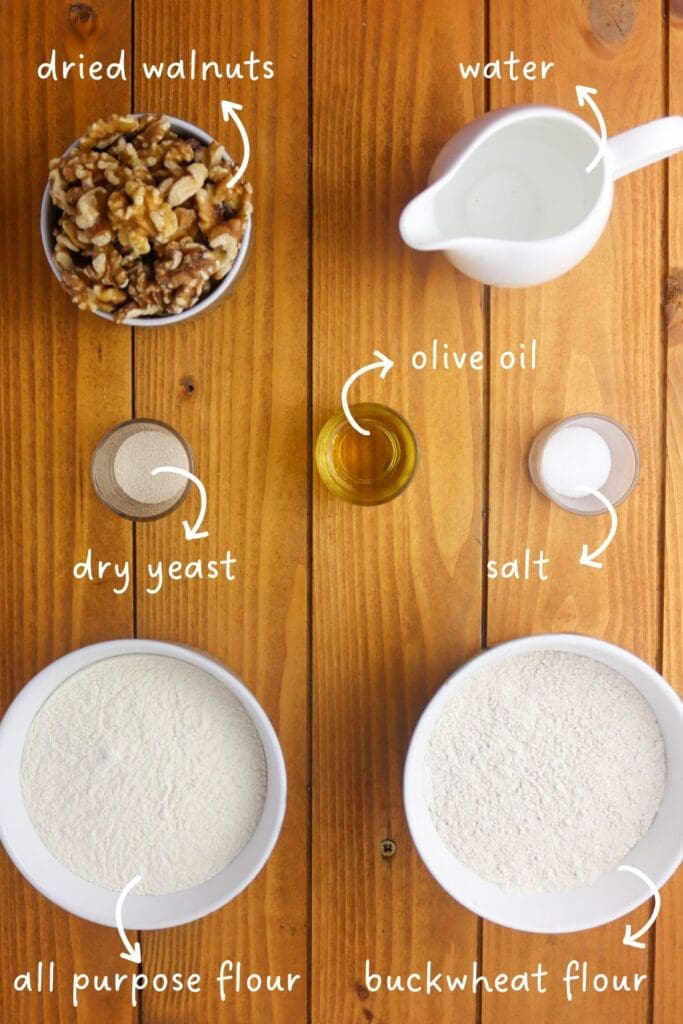
BUCKWHEAT FLOUR – Organic buckwheat flour is highly nutritious. It’s rich in fiber, protein, and essential minerals such as magnesium, iron, and B vitamins. And it contains zero gluten. Did you try our buckwheat noodles, buckwheat clafoutis and buckwheat plum cheesecake?
ALL-PURPOSE FLOUR – we use a blend of buckwheat and all-purpose flour to create a balanced and structured bread. Buckwheat flour adds flavor and nutrition, while all-purpose flour provides the dough with elasticity and strength due to its higher gluten content.
If you wish to make a healthier version of the bread, use wholemeal flour or rye flour. The bread could get a little sturdier, though.
WALNUTS – If using home-dried walnuts is not possible, store-bought ones will suffice. Remember to roast them before adding to the bread.
DRY YEAST – This small but mighty ingredient plays a key role in making our bread come to life. Dry yeast is a reliable and easy-to-use option that ensures a good rise and a soft texture. But if you opt to use fresh yeast, don’t hesitate to do so, as it can deliver even better outcomes. Just remember to use the appropriate amount.
OLIVE OIL – The use of olive oil in bread-making not only enhances the flavor, but also results in a delicate texture and a beautifully golden crust.
SALT – You can adjust this to taste. A pinch of salt also helps to regulate the yeast’s activity and strengthens the gluten structure.
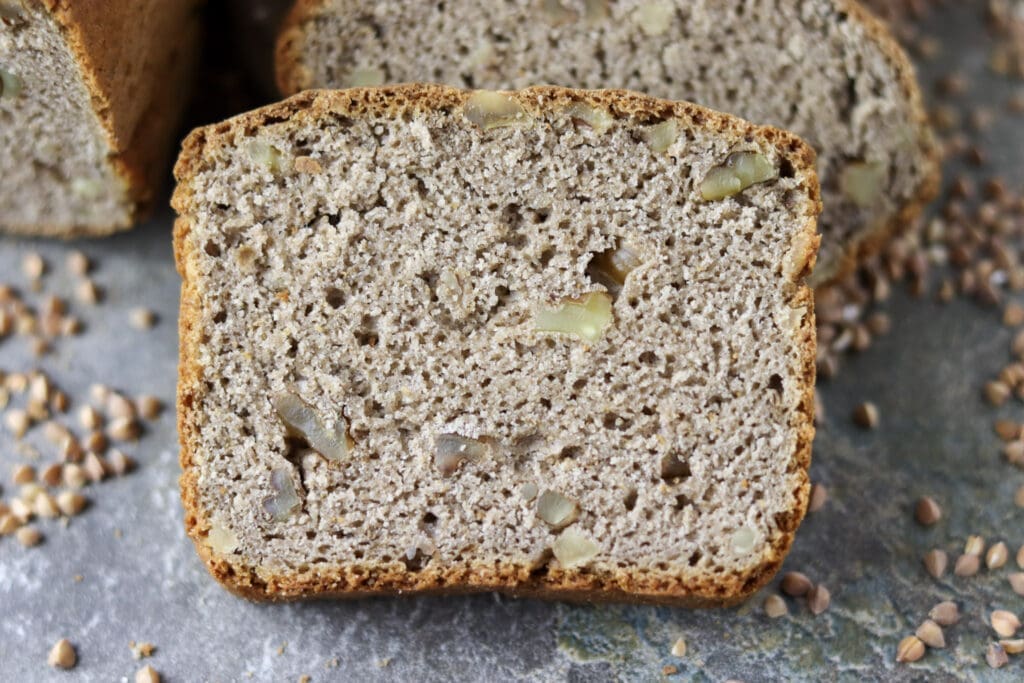
Buckwheat bread with walnuts easy recipe
HOW TO MAKE THE DOUGH
STEP 1: Prepare two bowls. Pour 2.4 dl (roughly 1 cup) of hot water over the buckwheat flour. Mix thoroughly and let it cool to a few degrees warmer than room temperature.


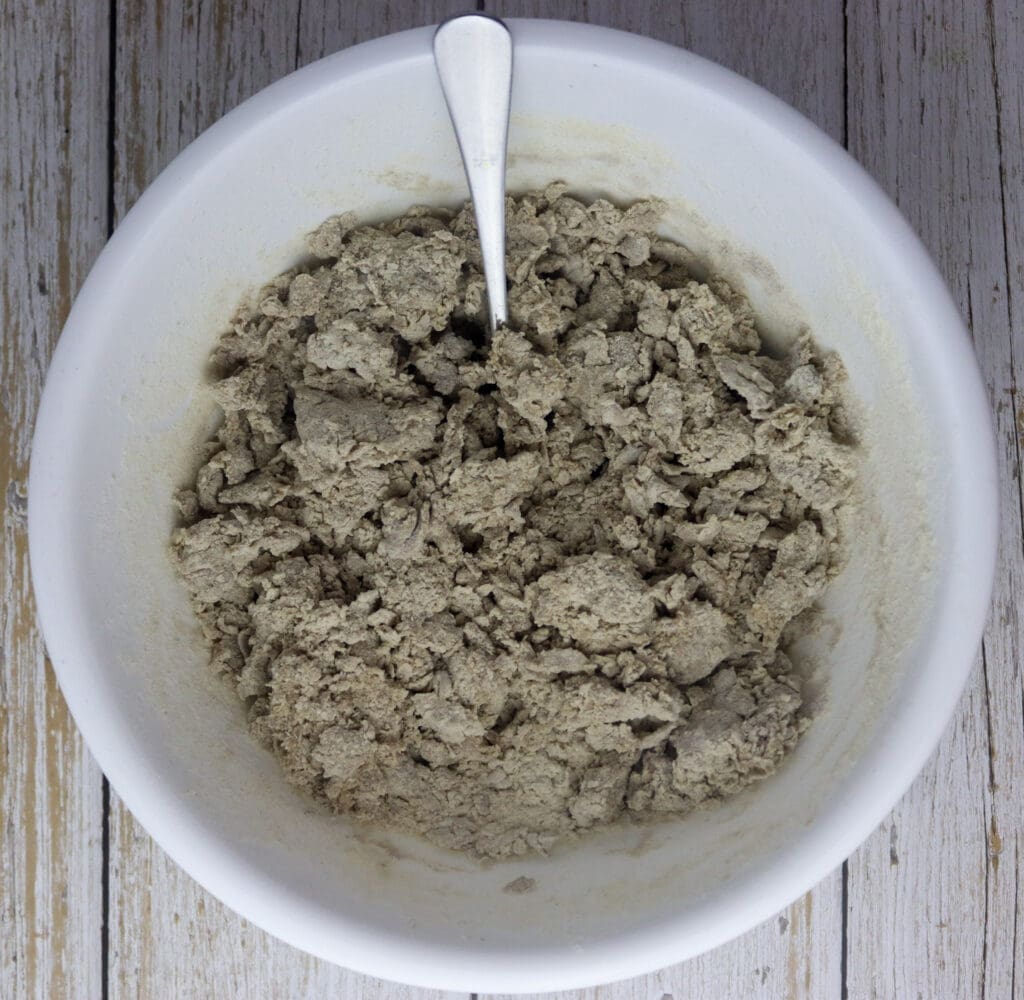
STEP 2: In the second bowl, combine the remaining dry ingredients: all-purpose flour, dry yeast, and a pinch of salt.
STEP 3: After the buckwheat flour has cooled down, add all of the dry ingredients to the same bowl. Knead the mixture for at least eight minutes until you get a smooth, elastic ball of dough.
When making bread recipes that use flour like buckwheat, which is naturally less rich in gluten, the dough may not attain the same elasticity and smoothness as white bread dough. However, it should still exhibit some signs of stretchiness after adequate kneading.
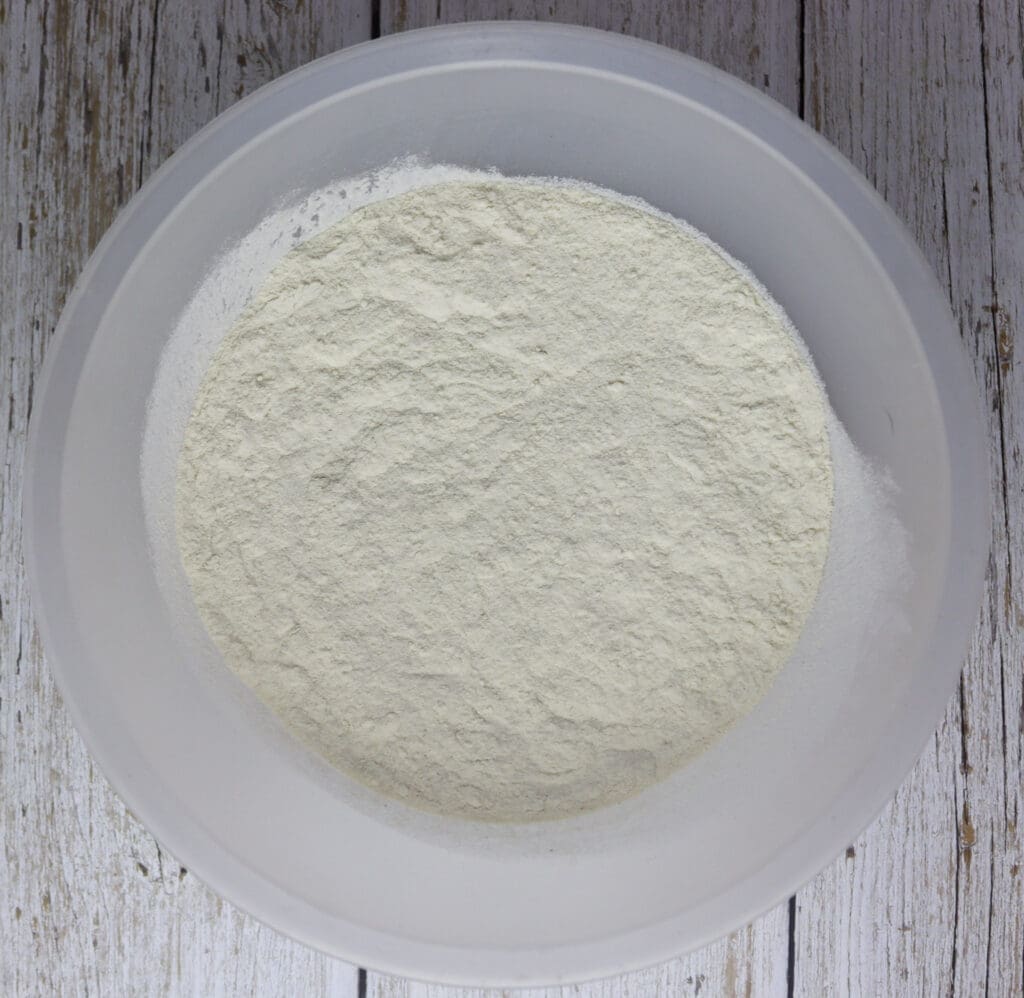

STEP 4: Place the dough in a bowl, cover it with plastic wrap or a kitchen towel, and let it rest for at least an hour. Wait until the dough has doubled in size before using it again.
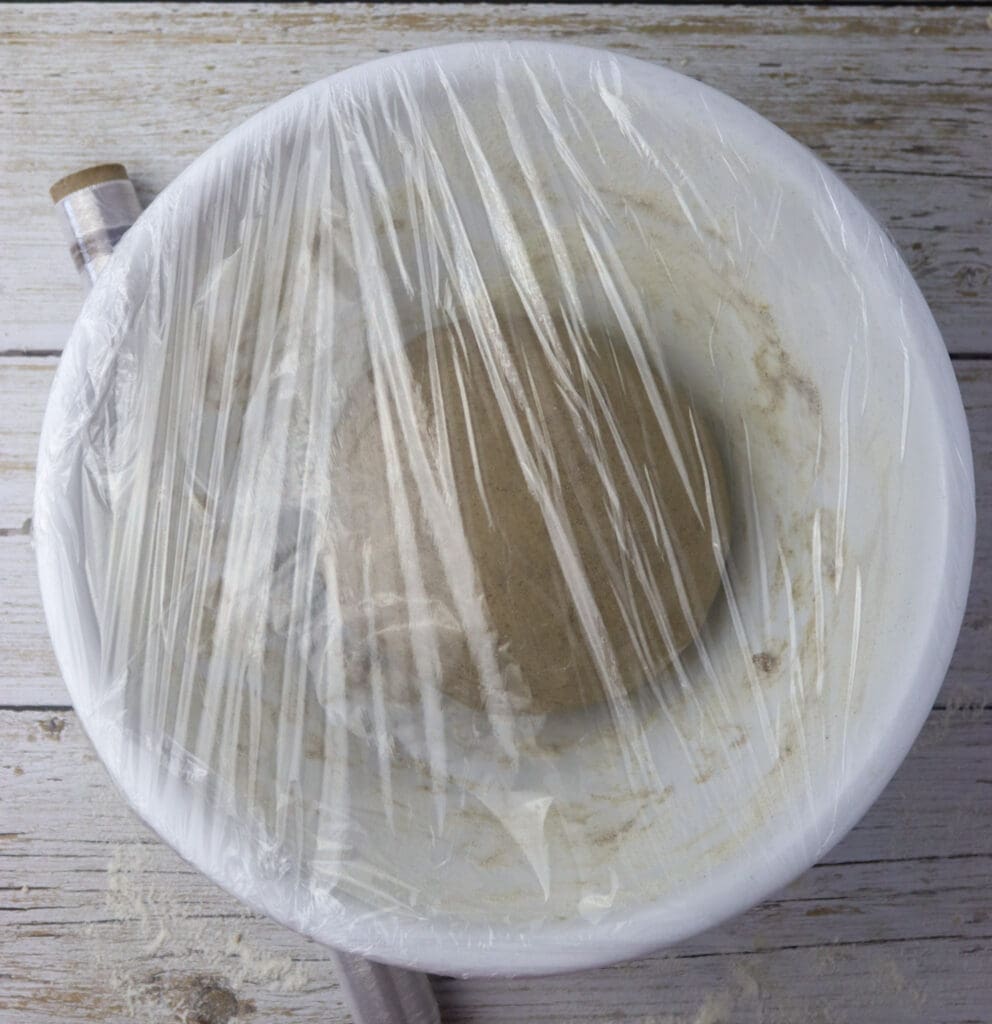
STEP 5: In the meantime, chop the walnuts into smaller pieces and toast them for a few minutes. This step is essential to enhance the flavor of the bread. You could use dry walnuts without roasting, but the bread won’t be as delicious.
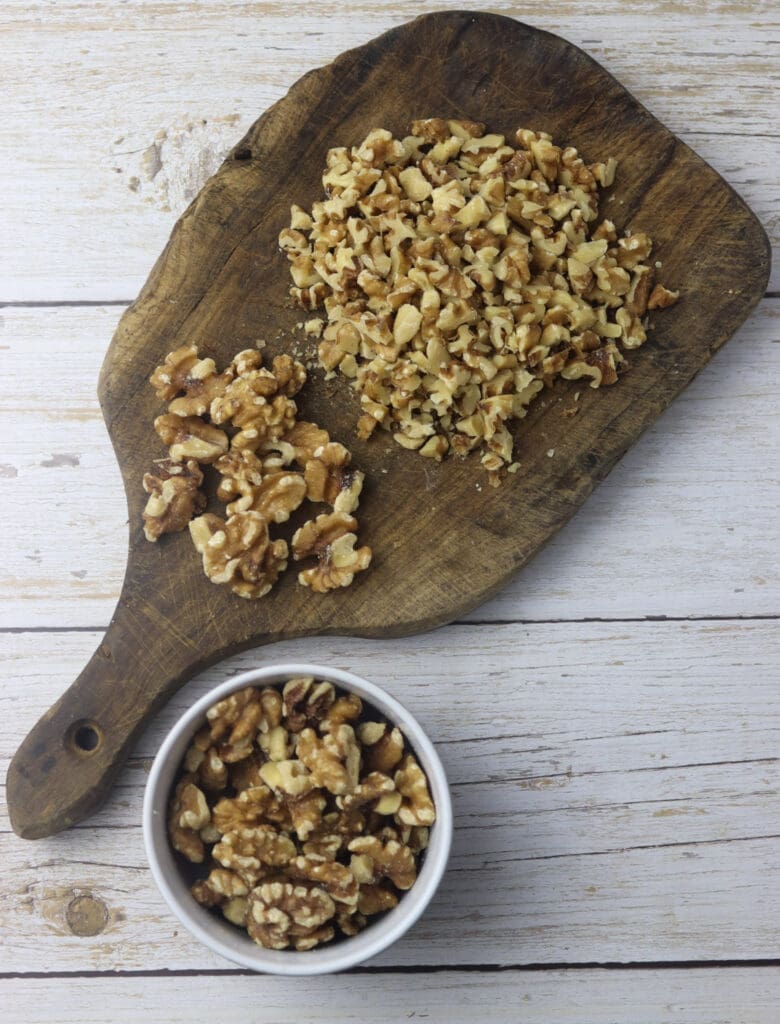

ADDING WALNUTS
STEP 6: After the dough has risen to double its size, transfer it to a clean, floured counter and knead it with roasted walnuts.
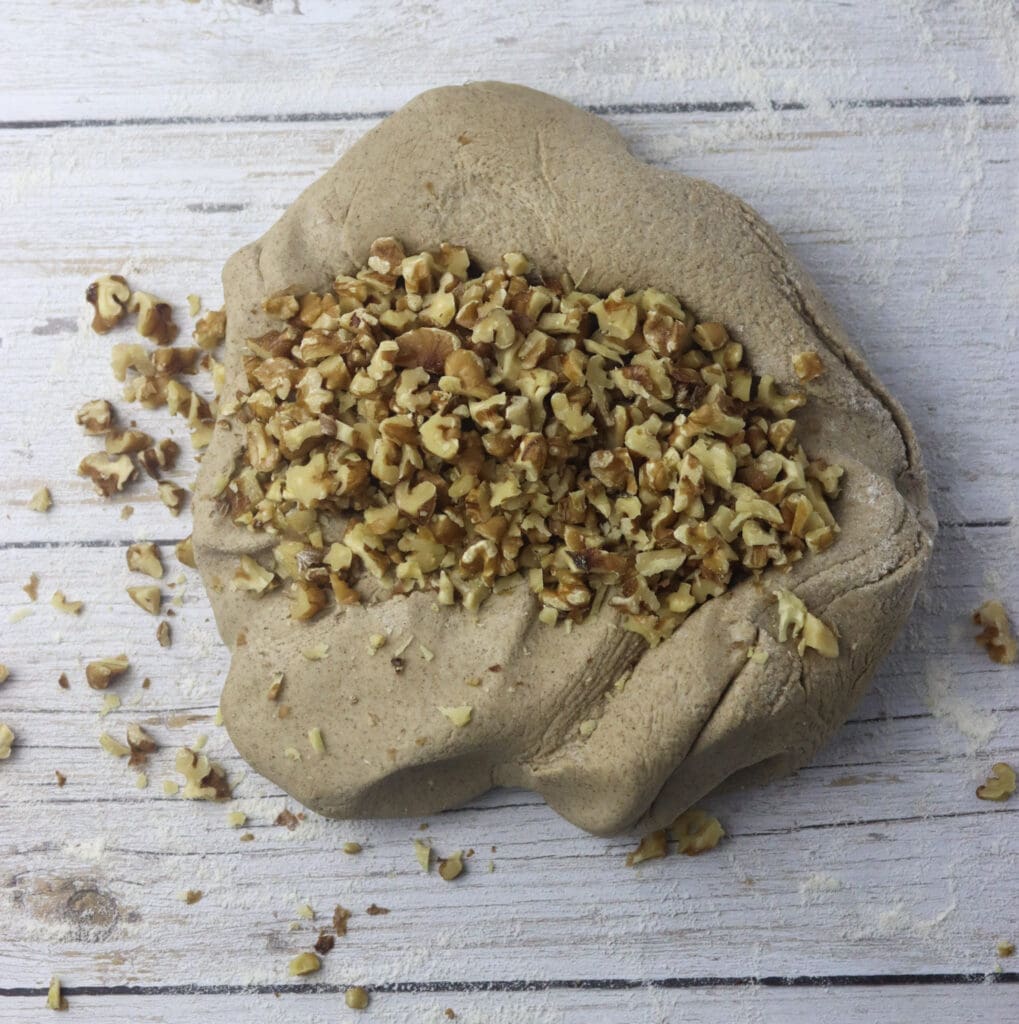
STEP 7: Once you have finished preparing the dough, transfer it to a loaf pan. If you prefer a firmer crust, use a regular baking sheet. Generally, the crust will be slightly softer in a loaf pan, but the bread will still be delicious. Using a regular pan allows you to decorate the surface.

Cover the pan with a kitchen towel and let the dough rest again until it doubles in size. Remember, the dough should be placed in a warm place with no drought.
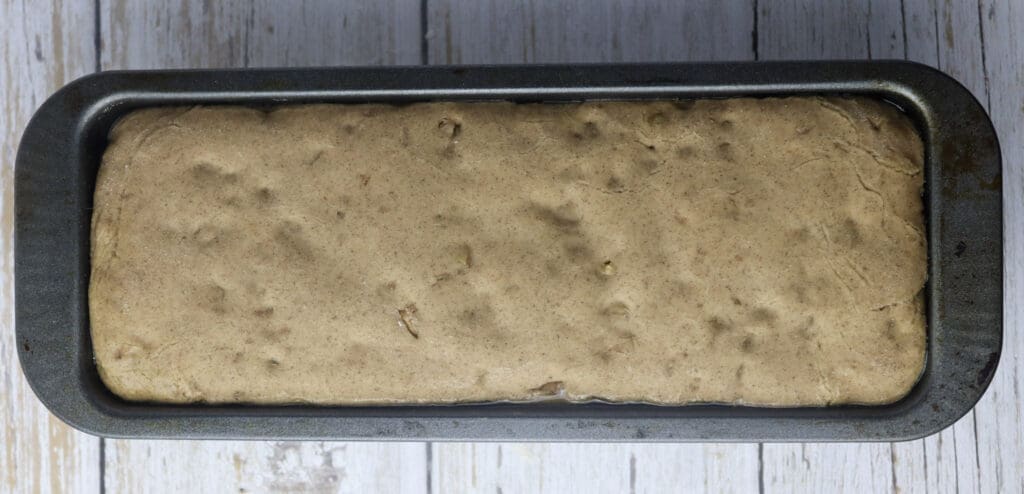
HOW TO BAKE IT
STEP 8: Preheat the oven to 210 C/410 F.
STEP 9: Once the dough has risen, transfer it to the oven. Bake at 210 C/410 F for 10 minutes. After that, reduce the temperature to 190,5 C/375 F and bake for another 35 minutes.
STEP 10: If the oven’s fan is on and the crust is getting too dark, cover the pan with parchment paper.
For a softer bread, place a small bowl of water beneath the bread to create steam. This will enable the crust to form more slowly.
STEP 12: After baking, wrap the bread in a clean kitchen towel and let it cool for another 20 minutes.
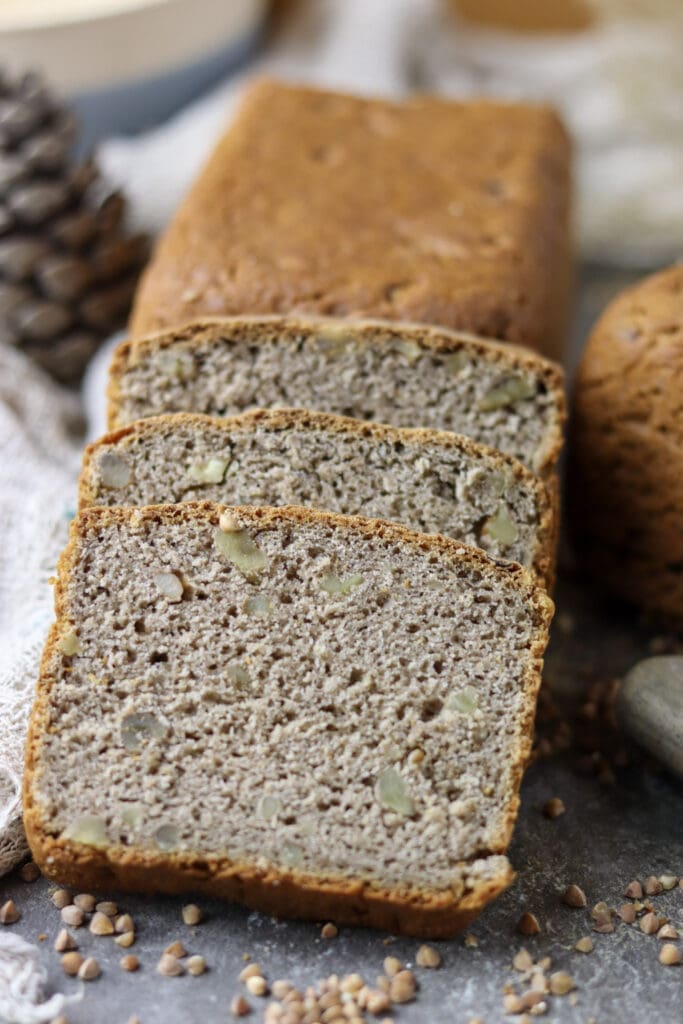
Buckwheat bread with walnuts variations
- Sourdough – for a healthier version of your buckwheat bread, use sourdough instead of yeasted all-purpose flour.
- Use other types of flour like wholegrain, rye, corn flour or prepacked gluten-free flour
- Bake gluten-free bread using only buckwheat flour with added psyllium husk and chia seeds.
- Add more goodies to the dough, like hazelnuts, pumpkin seeds and linseed

Some tips to remember
- Opt for high-quality buckwheat flour. You may find light or dark varieties; the darker flour has a stronger flavor and denser texture.
- It is crucial to toast the walnuts before adding them to the dough in order to significantly enhance the taste and texture of the bread. Don’t skip this step if you want your bread to have a deliciously crunchy and nutty flavor.
- Knead the dough thoroughly and let it rise to at least double size. The dough should be resting in a warm place, covered with a cover, plastic foil or kitchen towel to prevent any drought caching your bread.
- Buckwheat flour absorbs more liquid than wheat flour. Ensure your dough is adequately hydrated to avoid a dry loaf.
- Another good idea is to place a small bowl of water in the oven. The steam created by the water will help keep the outer layer of the dough moist during the initial phase of baking. This moisture prevents the crust from forming too quickly, allowing the bread to continue rising and expanding (also known as “oven spring”). Additionally, the steam contributes to the quality of the crust, creating a crispy, shiny, and beautifully golden brown crust.
- Reduce the temperature after an initial 5 to 10 minutes of baking, and cover the bread with parchment paper if you notice the crust is getting too dark.
- Allow the bread to cool after baking; buckwheat bread can be quite fragile while still hot.
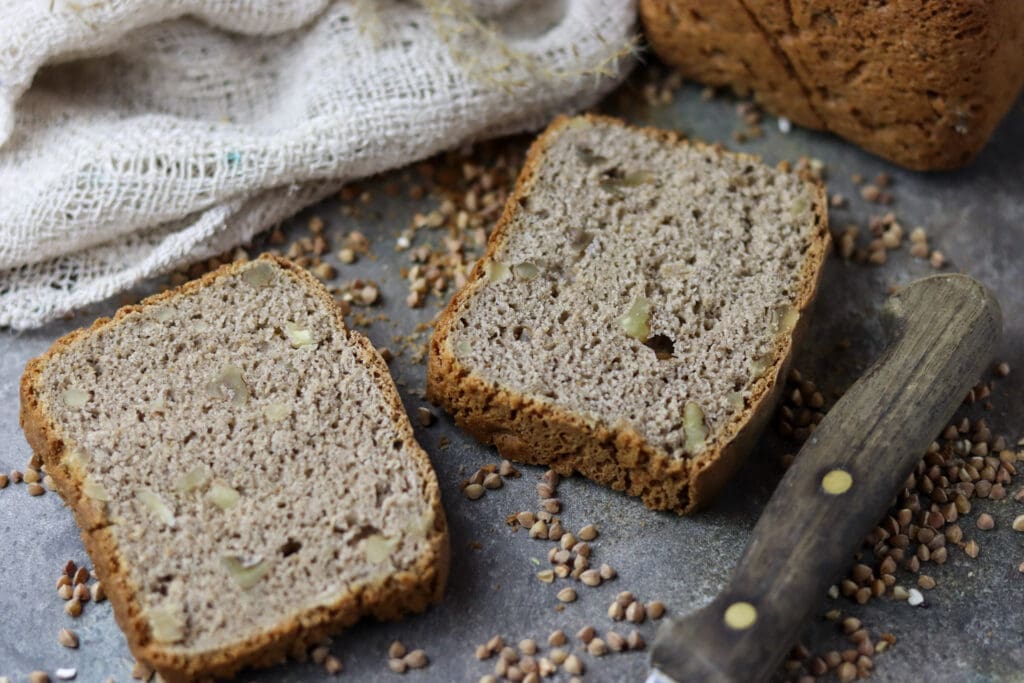
Storage and freezing
Buckwheat bread with walnuts can be stored at room temperature for up to 3 or 4 days. To keep it fresh, wrap the bread in aluminum or plastic foil, store it in a bread box, or place it in an airtight container.
Unlike all-purpose bread, buckwheat bread doesn’t dry out quickly, so it can last for a day or two longer.
If you wish to freeze your bread, wrap the loaf or individual slices in an aluminum foil. Then, place them in a freezer-safe bag or container. Make sure to remove as much air as possible from the bag or container to prevent freezer burn. It can be frozen for up to three months.
Thaw on the counter at room temperature. If the bread feels a bit dry after thawing, you can refresh it in the oven. Preheat the oven to 350°F (175°C) and heat the bread for about 10 minutes or until it’s warm and the crust is crispy.
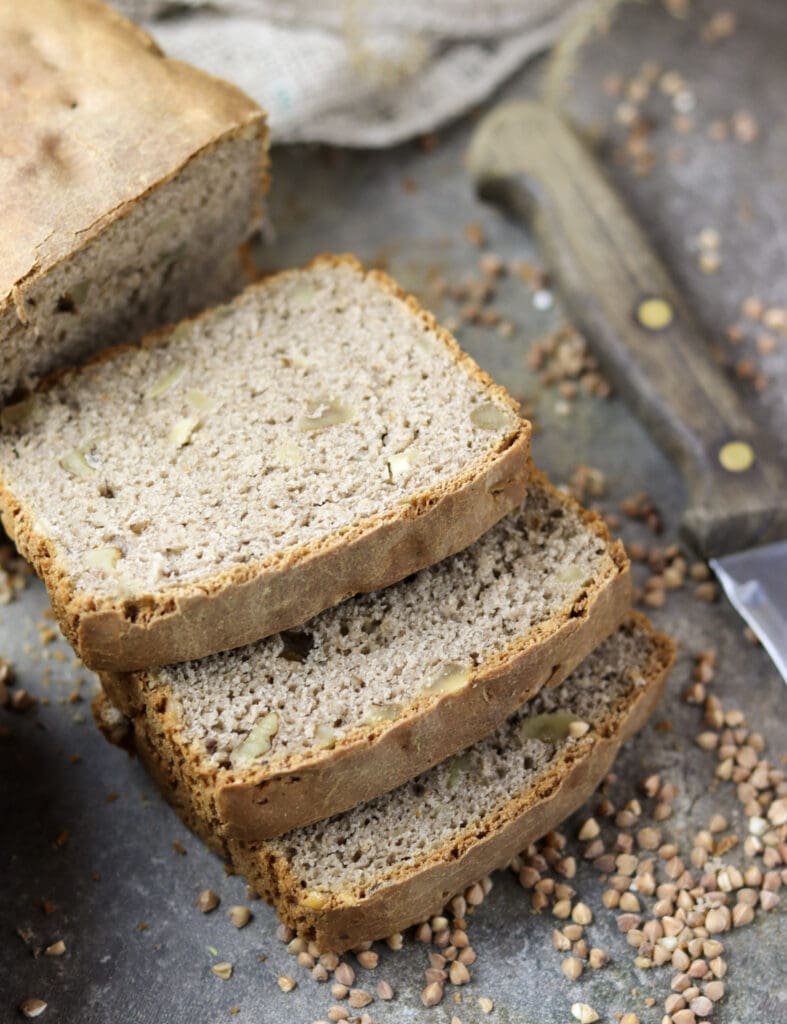
Buckwheat bread with walnuts FAQs
Roasting walnuts before baking enhances their flavor and aroma, improves texture by making them crisper, releases flavorful oils to your bread, and can extend their shelf life. Dried walnuts sometimes have a bitter taste due to the tannins, but roasting will greatly reduce that.
When baking with buckwheat flour, an effective technique is to mix it with boiled water before baking, also known as scalding. This helps to gelatinize the starches, resulting in improved moisture retention and a softer texture. It also brings out the natural nutty flavor of the flour and makes the dough easier to handle. By preventing baked goods from drying out quickly, scalding can also extend their shelf life.
Yes, it is possible to substitute plain flour with buckwheat flour. However, keep in mind that buckwheat flour is gluten-free and has a unique taste, which can alter the texture and flavor of your recipe. You may need to tweak the amount of liquid ingredients and add a binding agent such as xanthan gum, psyllium husk, chia seeds, or eggs to ensure the structure of your dish.
Buckwheat flour brings a distinctive, earthy flavor and dense, hearty texture to bread that cannot be matched by wheat flour. Being gluten-free, it does not rise as much as wheat-based breads, resulting in a more compact crumb. However, it significantly enhances the nutritional value by providing high fiber, protein, and essential minerals, making it an obvious choice for those who prioritize health.
Buckwheat bread with walnuts is a healthy choice, rich in fiber, nutrients, and omega-3. It has less gluten and a lower glycemic index. Both buckwheat and walnuts are high in antioxidants.
Buckwheat flour is definitely not a strong flour, as it lacks gluten, which is a defining characteristic of strong flours like bread flour. The protein structure of buckwheat flour is distinct and gluten-free, making it more appropriate for dense and hearty baked goods, rather than light and elastic breads that require strong flours.
“Yes, buckwheat flour can rise when used with baking powder. Baking powder is a leavening agent that releases carbon dioxide when moistened and heated, helping the dough to expand. However, due to the absence of gluten in buckwheat flour, the rise may not be as substantial as with wheat flour.”
Buckwheat bread is a nutritious choice. It’s low in gluten, high in fiber, and rich in essential nutrients like potassium and B vitamins. It contains all eight essential amino acids for effective absorption, and its low glycemic index and high antioxidant content help reduce inflammation and blood pressure. Adding walnuts to the mix boosts its nutritional content even further.
Delicious food you might like
Buckwheat soda bread with yogurt
Focaccia with sun-dried tomatoes
Buckwheat Bread with Walnuts
EQUIPMENT
- 1 loaf pan
INGREDIENTS
- 250 g (2 cups) buckwheat flour
- 250 g (2 cups) all purpose flour
- 250 ml (1.1 cups) water
- 16 g (1 package) dry active yeast
- 1 tsp salt
- 1 tbsp olive oil
- 125 g (1 cup) dried walnuts
INSTRUCTIONS
- Place the buckwheat flour into a bowl and pour over boiled water. Let it rest for few minutes to cool down to a luke warm temperature.
- In another bowl, mix together all-purpose flour, dry yeast and salt.
- After the buckwheat flour has cooled, mix it together with dry ingredients. Knead for at least 10 minutes.
- Transfer the dough back to the bowl, cover it with a kitchen towel or plastic foil, and let it rest for one hour. The dough should double in size before you continue working with it.
- In the meantime, cut the walnuts into smaller pieces and quickly toast them in a pan.
- When the dough is ready, knead it again and ad the toasted walnuts. The walnuts should be evenly incorporated in the dough.
- Transfer the dough to a greased loaf pan, cover it with a kitchen towel and let it rest in a warm place for another 45 minutes. Preheat the oven to 410 F/210 C.
- When the dough has risen properly, bake at 410 F/110 C for about 10 minutes. After that reduce the temperature to 375 F/190 C and bake for another 35 minutes until the crust looks crusty and golden.
- Wrap the freshly baked bread in a kitchen towel and allow it to rest for at least about 20 minutes before you serve it. Bon apetit!
Video
NOTES
- Use high-quality buckwheat flour, available in light or dark varieties. Dark flour has a stronger, denser profile.
- Toast walnuts before adding to the dough for enhanced flavor and crunch.
- Knead the dough well and let it double in size in a warm, draft-free area, covered with a kitchen cloth or plastic foil.
- Place a bowl of water in the oven during baking. This creates steam, aiding in crust development and oven spring, resulting in a crispy, shiny, golden crust.
- Lower the oven temperature after the first 5-10 minutes and cover with parchment if the crust darkens too much.
- Cool the bread completely before slicing, as buckwheat bread can be very delicate when hot.
- For a healthier buckwheat bread, opt for sourdough over yeasted flour. Experiment with other flours like wholegrain, rye, corn, or pre-packaged gluten-free mixes.
- For a gluten-free version, use pure buckwheat flour with psyllium husk and chia seeds.
- You can enhance the dough with additional ingredients like hazelnuts, pumpkin seeds, sunflower seeds and linseed.
- Buckwheat walnut bread stays fresh for 3-4 days at room temperature. Wrap it in aluminum or plastic foil, or keep it in a bread box or airtight container. It will last longer than a loaf or regular bread.
- It can be frozen for up to three months, ensuring you wrap the loaf (or individual slices) in aluminum foil and then place it in a freezer-safe bag or container.
NUTRITION
If you liked our buckwheat bread with walnuts, please rate it in the comments below.
Show your love by sharing ❤️


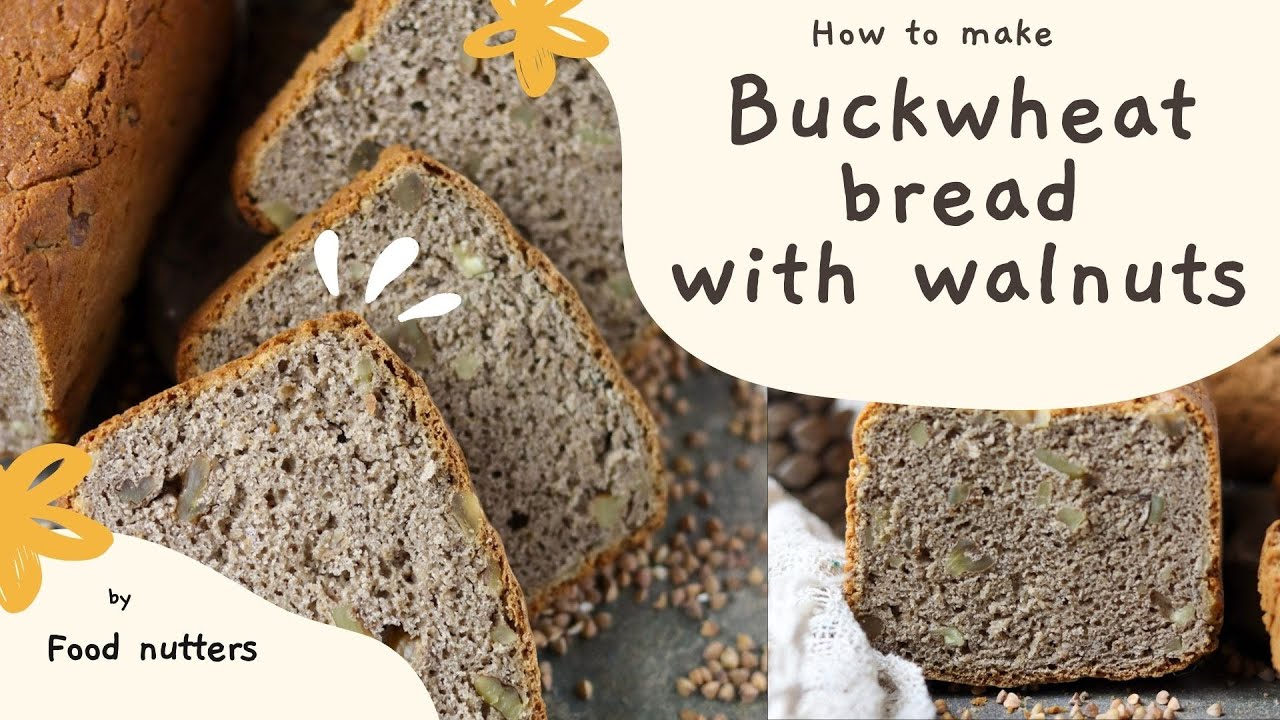
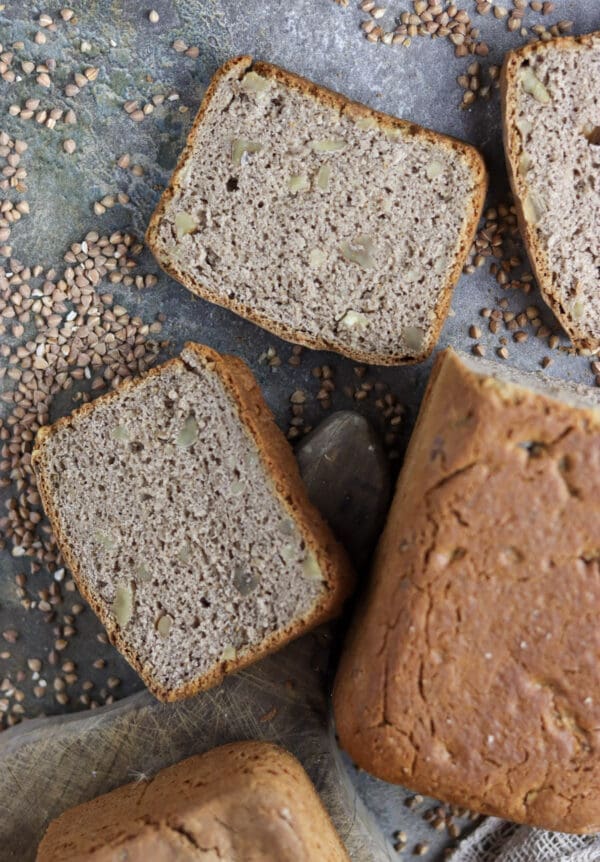

Bread and I am there, gonna have to try this one.
I visited you via Sew Can Do: Craftastic Monday Link Party Mid-winter Craftastic Monday Link Party
My links: 100+101. We will be so happy if you share your links with us at SeniorSalonPitStop. Link under BLOGGING.
Thanks Esme, I am sure you’re like it. Please let us know how it worked out!
What an adorable bread, we will try to make it on Sunday. I make buckwheat bread quite often, but it never came to my mind that I could add walnuts. Thank you for sharing.
Thanks Milo, I hope you’ll enjoy it.
I’m going to try out this recipe. It sounds amazing! Thank you for sharing your recipe with us.
Indeed, it was a pure joy posting this. The recipe is easy and the cookies were gone the same day 🙂
WOW! This bread looks beautiful!! Makes me want to toast some – Thanks for sharing at the What’s for Dinner party. Have a great weekend and see you tomorrow!
Thank you so much Helen, can’t wait to see you guys again 🙂
That’s really gorgeous loaf, never tried buckwheat before, may be would give this a try if I can get this here….